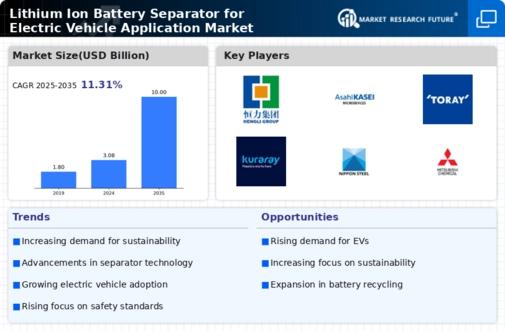Market Trends and Projections
The Global Lithium Ion Battery Separator for Electric Vehicle Application Market Industry is characterized by dynamic trends and projections. The market is expected to experience substantial growth, with a forecasted value of 3.08 USD Billion in 2024 and an anticipated increase to 10 USD Billion by 2035. The compound annual growth rate (CAGR) of 11.3% from 2025 to 2035 reflects the industry's robust expansion. These trends indicate a strong demand for innovative battery technologies, driven by the increasing adoption of electric vehicles and the need for efficient energy storage solutions.
Regulatory Support and Incentives
Government policies and incentives aimed at promoting electric vehicle adoption are a significant driver for the Global Lithium Ion Battery Separator for Electric Vehicle Application Market Industry. Many countries are implementing subsidies, tax breaks, and infrastructure development to encourage EV purchases. This regulatory support not only boosts consumer confidence but also stimulates investment in battery technologies, including separators. As a result, the market is poised for growth, with projections indicating a potential increase to 10 USD Billion by 2035. Such initiatives are crucial for achieving sustainability goals and reducing carbon footprints in the transportation sector.
Growing Demand for Electric Vehicles
The increasing adoption of electric vehicles (EVs) is a primary driver for the Global Lithium Ion Battery Separator for Electric Vehicle Application Market Industry. As governments worldwide implement stricter emissions regulations and provide incentives for EV purchases, the market is projected to reach 3.08 USD Billion in 2024. This surge in demand for EVs necessitates advanced battery technologies, where separators play a crucial role in enhancing battery performance and safety. The transition towards sustainable transportation solutions is likely to propel the market further, as manufacturers seek to improve energy density and reduce charging times.
Increased Investment in Renewable Energy
The global shift towards renewable energy sources is driving the demand for electric vehicles and, consequently, the Global Lithium Ion Battery Separator for Electric Vehicle Application Market Industry. As countries invest in solar, wind, and other renewable technologies, the need for efficient energy storage solutions becomes paramount. Lithium-ion batteries, supported by high-performance separators, are essential for storing energy generated from renewable sources. This trend is expected to bolster the market, as the integration of renewable energy with electric vehicle infrastructure becomes more prevalent, further enhancing the appeal of lithium-ion technology in the automotive sector.
Technological Advancements in Battery Technology
Innovations in battery technology are significantly influencing the Global Lithium Ion Battery Separator for Electric Vehicle Application Market Industry. Research and development efforts are focused on enhancing separator materials to improve thermal stability and ionic conductivity. For instance, advancements in polymer-based separators are expected to enhance battery efficiency and lifespan. As the market evolves, these technological improvements are anticipated to contribute to a compound annual growth rate (CAGR) of 11.3% from 2025 to 2035. This growth is indicative of the industry's commitment to developing safer and more efficient battery systems for electric vehicles.
Rising Consumer Awareness of Environmental Issues
Consumer awareness regarding environmental sustainability is increasingly influencing the Global Lithium Ion Battery Separator for Electric Vehicle Application Market Industry. As individuals become more conscious of their carbon footprints, the demand for electric vehicles is rising. This shift in consumer behavior is prompting manufacturers to prioritize eco-friendly battery solutions, including advanced separators that enhance battery performance while minimizing environmental impact. The growing preference for sustainable products is likely to drive market growth, as consumers seek to align their purchasing decisions with their values, further supporting the transition to electric mobility.











